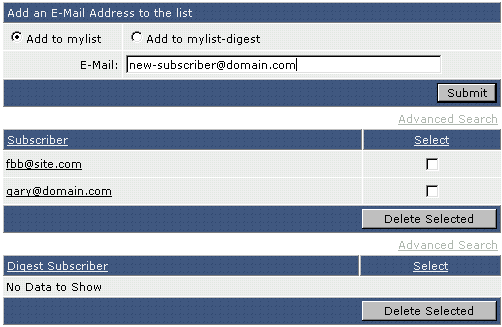Knowledgebase
Mailing Lists Print this Article
To create a mailing list, first access the "E-Mail Menu" from the control panel. Then, click the "Mailing Lists" icon. There will be no lists present, so click on "Create Mailing List."

Enter a name for your list and then click the "Create" button. You will then be taken back to the main mailing list menu and your new list will be visible in the table.
Note: You cannot create a mailing list if the name already exists as a POP3 account, autoresponder, or forwarder.
Subscribing / Unsubscribing by E-Mail
The server uses the popular Majordomo mailing list software. Traditionally, mailing lists have been operated and configured exclusively through e-mail. There are two ways to subscribe to a mailing list:
1. Send an e-mail to [email protected] and type "subscribe listname" (without quotes) in the message body.
2. Send an e-mail to [email protected] and type "subscribe" (without quotes) in the message body.
Each list is also available in digest form. This means that messages are stored and then sent out once per period (e.g. weekly) in one big message. This is useful in larger lists to assure that recipients don't get overwhelmed by daily messages. To subscribe to the digest version of the list, follow the same procedure for subscribing except use:
1. "subscribe listname-digest" instead of "subscribe listname."
2. [email protected] instead of [email protected]
The steps to unsubscribing are identical to subscribing except that you replace the word "subscribe" with "unsubscribe" in the message body. Majordomo will send you a results e-mail if the subscribe/unsubscribe was successful. In addition, you may view the list of subscribers from the control panel.
Subscribing / Unsubscribing Using the Control Panel
You may add and remove subscribers yourself through the control panel. Please note that recipients get no confirmation message from Majordomo when they are added in this way. This means they have no way of knowing they are on a list until somebody e-mails the list or you tell them.
The first step involves selecting the list you want to modify. All mailing lists are visible from the mailing lists menu. Click the "view" link next to the list name you want to work with. You will then see a box that looks like this:

Adding a subscriber can be done by checking either "Add to listname" or "Add to listname-digest" and then clicking the "Submit" button. Unsubscribing is done by clicking the checkbox(es) next to the address(es) you wish to remove, and then click the "Delete Selected" button. All subscribers will be listed here regardless of how they subscribed to the mailing list (by e-mail or through the control panel).
Changing Mailing List Settings
The control panel provides you with a graphical interface to change the Majordomo configuration. To access this feature, go to the main mailing list menu and click the "view" link next to the list you want to modify. At the top of the screen you will see another link: "To change list and digest settings, click here." This link will take you to the configuration menu.
The configuration menu allows you to change features of the mailing list including:
- List description
- Digest settings
- Subscribe policy
- Maximum message length
- Moderators
- Much more...
The configuration menu is best used by those who have experience with Majordomo. We suggest you visit the Majordomo Home Page for more information.
Was this answer helpful?
Related Articles
Free e-mail services such as everyone.net require that MX changes be made in order for their...
To create an e-mail account, sign into the control panel and then click on the "E-Mail Menu"...
When The server receives e-mail to addresses that don't exist, it has to do something with those...
Forwarders allow you to direct incoming mail to a different address. For example, assume...
Vacation messages tell others that you are away. A common vacation message may sound like:...

